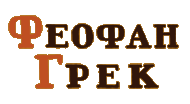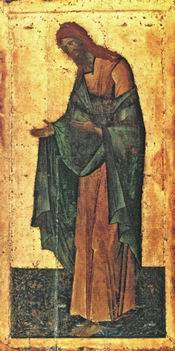

|
|
The System of Frescoes and Its General Idea
|
 |
|
|
Theophanes the Greek is responsible only for a part of the frescoes in the Church of the Saviour, which he painted with assistants. Many Russian inscriptions side by side with Greek ones are come across in the church. Theophanes must have had Russian pupils at that time already, helping him in his work. However the paintings in the Church of the Saviour display stylistic affinity and may be considered a work of the outstanding Greek artist.
Theophanes' murals are far from being a customary type of church wall painting, which thoroughly follows the events from the Gospels. The pictures of Theophanes are imbued with the author's personal attitude to the subject. His keen individuality manifests itself either in the peculiar system of the ensemble, or specific spiritual tension of his art, in diverse and highly individualised images of the saints (we find ourselves studying them as portraits), and vigorous manner. The painter has nothing in common with different stylistic trends of the fourteenth century. The sources of his art are therefore difficult to be found. We do not see analogies to his style either in Constantinople or in Russia. The complex problem of the sources of Theophanes' artistic style should be solved with due regard for the fact that he was a wandering master. He worked in Constantinople, Galata, Caffa, Novgorod, Nizhny-Novgorod and Moscow. His going to the Balkans is quite possible. In those endless wanderings about different countries and cities Theophanes had to adapt himself to the local conditions and get accustomed to local tastes. So did his original style come into being, of which the frescoes from the Church of the Saviour of the Transfiguration give the most exhausting idea.
On the Question of Interpretation of the Frescoes from the Church of the Saviour
Contemporaries call Theophanes good company. Even at work he held a neverceasing interesting conversation with friends and disciples. One of the early fifteenth-century chronicler mentions him as "acelebrated sage and highly cunning philosopher".... Such definition stimulates the study of the contacts which the artist maintained with intellectual life of Byzantium and Russia in the fourteenth century. In the wall painting of the Church of the Saviour Theophanes undoubtedly expressed the general idea of the God and Man, worked out in his epoch, as well as his personal world outlook. This was the outlook of an intellectual artist and philosopher.
There are strong grounds for saying that Theophanes showed great interest in the ideas of Hesychasts, the main trend in religious and philosophical life of the fourteenth century. But, to quote Professor M. V. Alpatov's words, he was captivated not so much by the dogmas of the official representatives of the neo-Hesychasts of the middle of the fourteenth century headed by St Gregory Palamas, as by the teaching as a whole, beginning from the heroic time of the first ascetics (fourth-fifth century) like St Macarius of Egypt or St Ephrem the Syrian, whom he depicted in the frescoes of the chamber.
In the Hesychastic discussions shaking Byzantium a considerable place was occupied by the teaching of the divine energies the light being their visible form. It was not without reason that Theophanes cultivated in his artistic style those devices which he used to convey not colour nuances but the light. The energetic highlights which do not depend on the concrete source of light serve to strengthen the impression of dramatic tension. This mystic dynamic light exactly corresponds to the description of light in the visions of the Byzantine saints, for instance, St Simeon the New Theologian, one of the forerunners of the fourteenth-century Hesychasts. Theophanes demonstrates in the visual form the process of the spiritualization of the flesh propagated by the Byzantine mysticism. But the painter's work viewed as a whole is not characterised by such high degree of completeness, which would harmonise with the doctrine of neo-Hesychasts, assuming the long amalgamation of Man with the emanations of God. Theophanes is full of doubts as to the final result of the Hesychia. Though all the thoughts and feelings of saints in his frescoes are bent on seeking God they are not given to enjoy the divine immortality. He affirms that even the greatest ascetics cannot get out of unending searches and sufferings. There is a widely spread opinion that Theophanes the Greek has exceeded the limits of the religious thinking and may be looked upon as one of the representatives of the Renaissance philosophy. The author allows himself not to agree to this opinion and to consider Theophanes purely medieval artist and thinker. The painter does not believe in the power and potentialities of Man and maintains that there can be no happiness on Earth, just inner torments, sufferings of the flesh and the inevitable destruction brought by death. His saints fully depend on the outer forces.
Appendix: Some Words About the Exterior Painting of the Church of the Saviour in Novgorod
There are two exterior frescoes in the Church of the Saviour. One of them depicting the Virgin of the Sign is in the niche of the southern facade. Judging by its style the painting may be dated as far back as the late seventeenth or early eighteenth century. The Virgin Hodegetria is shown in the niche of the western facade. The face of the Virgin betrays a certain lack of fluidity in execution and a drier treatment. The fresco was evidently painted by a Russian or Southern Slav master in the late fourteenth century.
|
|